Click on link for video footage on how to replace the suction rings in your nanoCLEAR AR unit.
Click on link for video footage on how to replace the suction rings in your nanoCLEAR AR unit.

So as a staff member, why would I want to cast lenses?
Job security: Ever think it’d be easier to just call a lab and have the lenses made? It is easy. In fact it’s so easy that pretty much anyone can do it. Making lenses requires a little more effort, but it also makes you an integral part of the transaction. The person that makes the lenses is harder to do without than the person that orders them. Making lenses in-house also makes the practice you work for more profitable!
It’s pretty cool:  Do you ever think about the direct output of your efforts helping people see? You’re making something that improves their lives. You’re not just an order taker and delivery box. Some stores can’t even tell you what kind of lenses they’re selling. The corporate office or lab decides that for them and doesn’t feel the need to tell customers. If you make the lenses you’ll know more about how they behave and how they should be used. You become a more important part of your customers’ lives.
Do you ever think about the direct output of your efforts helping people see? You’re making something that improves their lives. You’re not just an order taker and delivery box. Some stores can’t even tell you what kind of lenses they’re selling. The corporate office or lab decides that for them and doesn’t feel the need to tell customers. If you make the lenses you’ll know more about how they behave and how they should be used. You become a more important part of your customers’ lives.
Keep it local: With economic worries and political unrest around the globe, more people are deciding they’d rather spend their time and money at local businesses. Let your customers know you’re actually MAKING their lenses at your store on equipment that’s made in the USA. If you need something out of range, our lab can probably surface it for you and it’ll still be made in the USA (we cast our own blanks in Louisville, KY and surface them in the same lab).
Differentiate yourself and the business: Remember earlier when we were talking about how easy it is to phone an order in? With Internet eyeglass retailers growing, the consumer can easily “phone in” a prescription too. It’s important to give the customer something they can’t get online, so they’ll want to come to your store. Whether it’s a quick turnaround, intimate knowledge of lenses and materials, or the fact that you’re going to personally make the lenses for the user, you have the opportunity to give your customers something a little more special. There are still lots of people that value a personal touch and want to build relationships with the businesses they frequent. Don’t underestimate the importance of those parts of the transaction.
And remember Casters Do it Better!
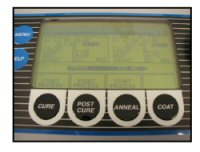 Some prescriptions will use different initialization cycles for each eye. The Q-2100 screen will show the word SPLIT when this occurs.
Some prescriptions will use different initialization cycles for each eye. The Q-2100 screen will show the word SPLIT when this occurs.
Split jobs require a few extra steps to complete them correctly. Fill both mold assemblies as usual and put them in the initial curing drawer with the fill port up. Press the CURE button once and the box just above the button will direct you to check for correct filter placement. Check the filters and continue when they are correctly placed.
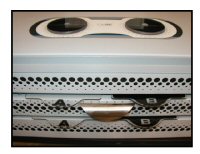 Press the CURE button a second time and the box will direct you to start curing the left or right assembly. The alert tone will sound when the first assembly has finished the initialization step. Remove it and place it in the post cure station and press the POST CURE button. Place the second mold cavity in the initialization drawer of the main chamber on the proper side and press CURE to start the initialization cycle for the second assembly.
Press the CURE button a second time and the box will direct you to start curing the left or right assembly. The alert tone will sound when the first assembly has finished the initialization step. Remove it and place it in the post cure station and press the POST CURE button. Place the second mold cavity in the initialization drawer of the main chamber on the proper side and press CURE to start the initialization cycle for the second assembly.
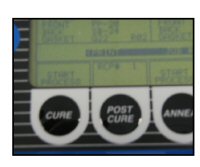 The tone will sound again when the second mold assembly is ready to be moved to the post cure station. Move the mold assembly from the main chamber to the empty post cure location in the post cure drawer. Press the POST CURE button again to stop the alert tone and continue the post cure cycle for the two cavities. The two assemblies will finish their curing cycles together. The tone will sound again when the post cure cycle is complete.
The tone will sound again when the second mold assembly is ready to be moved to the post cure station. Move the mold assembly from the main chamber to the empty post cure location in the post cure drawer. Press the POST CURE button again to stop the alert tone and continue the post cure cycle for the two cavities. The two assemblies will finish their curing cycles together. The tone will sound again when the post cure cycle is complete.
Demolding and annealing for split jobs are the same as any other job.
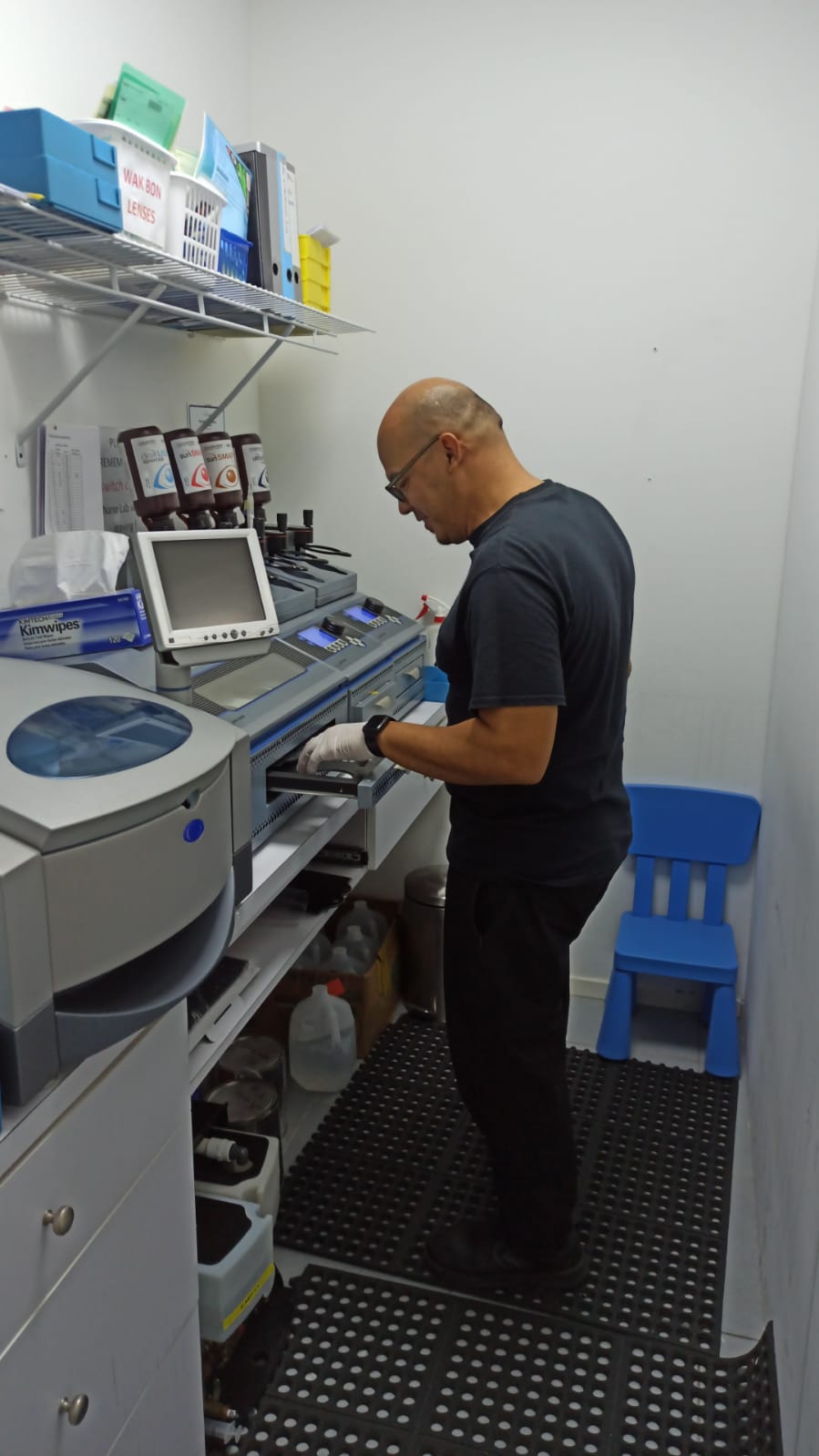 Offering the largest designer eyewear collection, the best prices and excellent service, they have a large selection of frames to suit any budget.
Offering the largest designer eyewear collection, the best prices and excellent service, they have a large selection of frames to suit any budget.
With the addition of the Q-2100 Digital Lens System and nanoCLEAR AR, Aruba Vision Center is excited to offer comprehensive service, with the just-in-time delivery of prescription eyewear to their patients.
Opting to carry clearLIGHT, sunSMART grey & brown, ultraSUN, blueVIEW and amplifEYE, their patients will have access to the full array of Optical Dynamics lenses.
At Aruba Vision Center, their motto, is “Excellent optical services to the entire Aruban community.”
 Our representatives from Optical Dynamics and Vision Dynamics Laboratory are pleased to attend this year’s Vision Expo West Thursday September 15th through Saturday September 17th. Although not exhibiting at the show, our representative will be available for onsite appointments should you wish to meet and discuss our Digital Lens Technology and/or Lab Services.
Our representatives from Optical Dynamics and Vision Dynamics Laboratory are pleased to attend this year’s Vision Expo West Thursday September 15th through Saturday September 17th. Although not exhibiting at the show, our representative will be available for onsite appointments should you wish to meet and discuss our Digital Lens Technology and/or Lab Services.
Attendees will include:
Exhibit hours for the event are as follows:
We look forward to meeting with you at this year’s event!
Cynthiana Vision Center located in Cynthiana Kentucky, purchased the Digital Lens Technology 19-years ago this month. Owner, Dr. Bret Hines, an innovator and pioneer was one of the first to experience the benefits of in-office lens casting . As shared on their practice website, Cynthiana Vision believes in providing patients with thorough eye health care and provides the latest in eye care technology and treatments.
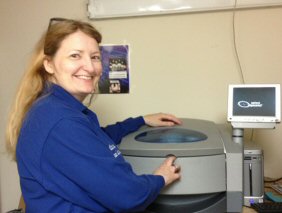 Angle Miller, optician at Cynthia Vision has been working with the technology since installation and is a big advocate of the system. “I love the speed of the lens production process,” said Angel. “It allows for a quicker order turn around over traditional labs and patients like that,” she added.
Angle Miller, optician at Cynthia Vision has been working with the technology since installation and is a big advocate of the system. “I love the speed of the lens production process,” said Angel. “It allows for a quicker order turn around over traditional labs and patients like that,” she added.
When asked to share a story of how a patient benefited from the onsite production, Angel said, “Bad weather was coming and a patient needed to travel out of state. We were able to get his lenses in a day with the nanoCLEAR unit, and he was able to avoid the snowstorm in his travels.” Processing lenses on site definitely allows for a unique competitive advantage in the optical market place.
Ask the Labs, Eyecare Business
If a patient has a high-plus or high-minus Rx, which frame characteristics should be taken into consideration to ensure it will work best with the lenses?
When working with a patient with a high-plus or high-minus lens Rx, say over four or five diopters in total power, the following tips can help:
In general, rounder and smaller shapes are best for reducing edge thickness. One key factor in reducing edge thickness is picking a frame that requires the least amount of decentration. Decentration is the natural enemy of high-power lenses, as decentration increases, so does edge thickness. Another way to look at it: The closer the geometric center of each eye is to the pupil, the less edge thickness there will be.
Of course, other aspects of frame choice also have a role to play. A frame that hides more of the lens edge will help improve aesthetics— with plus lenses the thickness will tend to be in the nasal, with minus lenses it will be the temple edge. Be careful with drills and rimless groove frames; instead consider zyl or metal frames with thicker eyewires.
As for wraps, they are designed for lower powers, typically from -3.00D to +3.00D, and can become risky above this range. For wraps in general, we strongly recommend consulting the frame manufacturer to determine the lens range the frames were designed to accommodate.
— Swen Carlson, vice president, operations, VSP Optics Group
A Look at Lens Materials by Jenean Carlton, ABOC, Eyecare Business
Given all the considerations of lens materials, how do you make a decision about the best lens material for your patients? First, learn about the patient’s prescription and lifestyle needs and then research data about materials.
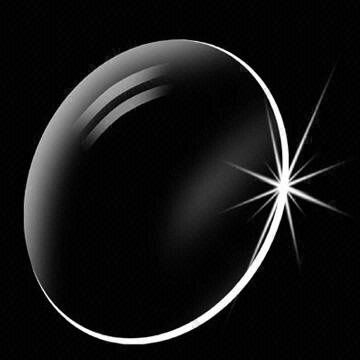 Index of Refraction: Index of refraction indicates how readily a lens material will refract a bean of light. The higher the index of refraction, the more the material will bend light rays. The higher the index of refraction, the thinner the lenses can be processed. Plus power lenses are thinner in the center when fabricated and minus lenses are thinner on the edges.
Index of Refraction: Index of refraction indicates how readily a lens material will refract a bean of light. The higher the index of refraction, the more the material will bend light rays. The higher the index of refraction, the thinner the lenses can be processed. Plus power lenses are thinner in the center when fabricated and minus lenses are thinner on the edges.
Abbe Value: White light is made up of the visible spectrum of wavelengths from 380nm to 760nm, with each wavelength corresponding to different colors of light. The higher the Abbe value of a material, the less likely it is to have problems with dispersion or chromatic aberration, which is perceived as color fringing or off axis blurring in the lens periphery.
Specific Gravity: Specific gravity is a measurement that determines a lens material’s weight. The lower the density or specific gravity of a material the lighter it will be when fabricated into a lens.
Reflectance: All lenses reflect at least a small percentage of light; some reflect a significant amount depending on the refractive index of the material. The higher the materials refractive index, the greater the percentage of light reflected from the lens surfaces. (END ARTICLE)
At Optical Dynamics, our clearLIGHT advantage lens combines the best of all attributes: